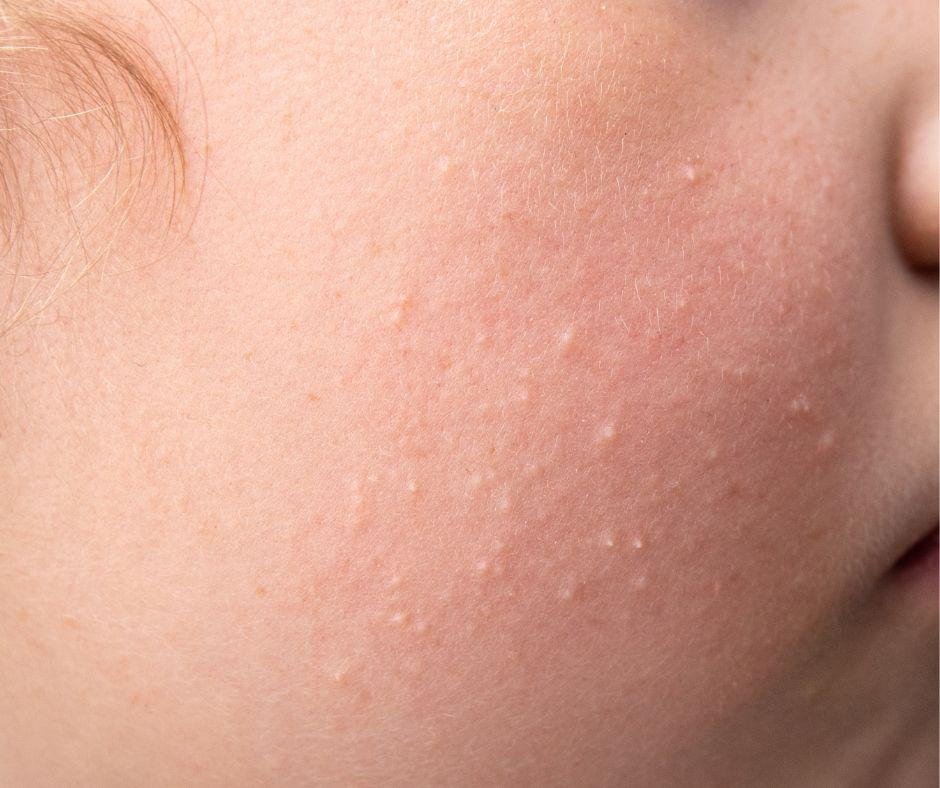All You Need to Know About Keratosis Pilaris

- posted: Feb. 28, 2023
Have you ever noticed small, white bumps or patches on your skin? Or maybe even a rough feeling on the surface of your arms or legs? You may be experiencing an incredibly common skin condition known as Keratosis pilaris, or KP. In this article, we will discuss what KP is, its causes, and how to treat it effectively.
What is Keratosis Pilaris?
Keratosis pilaris is a harmless and common skin condition that affects people of all ages. It manifests itself as tiny bumps or patches of dry, rough skin. These bumps are often white in color and can appear on any area of the body. Common areas for these bumps include the face, upper arms, and thighs.
KP is caused by an overproduction of keratin, a protein found in our skin, hair, and nails. This excess keratin clogs our hair follicles, resulting in raised bumps on the surface of the skin and making it difficult for moisturizing agents to penetrate into deeper layers of the skin. While KP can be unsightly and irritating, it is not contagious and poses no health risks.
Treating and Preventing Keratosis Pilaris
The good news is that there are several ways to treat KP at home. Here are some easy tips for managing your KP symptoms:
- Limit bath time and use warm water. One easy strategy to help ease Keratosis pilaris is to limit bath time and use tepid or warm water instead of hot when bathing. Doing this helps protect the skin’s natural oils which can be stripped away resulting in extremely dry skin– making Keratosis pilaris worse! Additionally, after bathing make sure to use an appropriate moisturizer to keep your skin feeling smooth and healthy.
- Use gentle cleansers. Look for mild soaps or cleansers that are free from fragrances, dyes, or other harsh ingredients when washing your affected areas. Fragrance-free products will protect your skin from becoming too irritated.
- Moisturize daily. Keeping your skin well-moisturized is one of the most important steps when it comes to managing Keratosis pilaris. Look for lotions and creams that contain lactic acid or urea, as these ingredients can help to soften rough patches and minimize redness. Apply moisturizer after each time you shower or bathe (while your skin is still damp) so it can really absorb the product.
- Exfoliate Gently. Gentle exfoliation can help clear away build-up of dead skin cells that can exacerbate KP symptoms. You may want to try using a loofah sponge or an exfoliating scrub with natural ingredients such as sugar or ground coffee beans once or twice per week. Be sure not to overdo it– too much exfoliation can irritate your skin further! It’s also important to avoid rough fabrics like wool which can cause friction against the bumps on your skin and make them worse.
- Try topical treatments. Topical creams containing retinoids or alpha hydroxy acids (AHAs) may be effective in reducing bumps associated with KP when used regularly over several weeks or months. Talk to your doctor about which treatment may be best for you.
- Adjust Your Diet. What we eat has been shown to play a role in how our bodies look and feel, including in cases of KP. Eating plenty of fruits and vegetables can help keep your skin healthy by providing essential nutrients while avoiding processed foods like chips and candy may prevent inflammation associated with KP flare ups. Additionally, Omega-3 rich foods such as salmon or flaxseed may be beneficial for reducing inflammation throughout the body and keeping your skin hydrated from within.
- Wear loose clothing. Tight-fitting clothes can exacerbate irritation caused by friction against the affected area. Wearing more breathable clothing during flare-ups can help reduce irritation symptoms associated with your KP.
- Use a humidifier. An environment or home with low humidity can dry out your skin. A home humidifier, especially during the winter months, will add moisture to the air inside your home and help keep your skin healthy and comfortable.
Whether you’re just starting out dealing with Keratosis pilaris or have been living with it for years, there are plenty of ways to manage its symptoms at home. With a combination of gentle cleansing agents, regular moisturizing and exfoliation techniques, as well as topical creams containing retinoids or AHAs, you can find relief from this common condition. Don’t let Keratosis pilaris get you down—take charge today! Contact us for a skin consultation.

- posted: Feb. 28, 2023
Have you ever noticed small, white bumps or patches on your skin? Or maybe even a rough feeling on the surface of your arms or legs? You may be experiencing an incredibly common skin condition known as Keratosis pilaris, or KP. In this article, we will discuss what KP is, its causes, and how to treat it effectively.
What is Keratosis Pilaris?
Keratosis pilaris is a harmless and common skin condition that affects people of all ages. It manifests itself as tiny bumps or patches of dry, rough skin. These bumps are often white in color and can appear on any area of the body. Common areas for these bumps include the face, upper arms, and thighs.
KP is caused by an overproduction of keratin, a protein found in our skin, hair, and nails. This excess keratin clogs our hair follicles, resulting in raised bumps on the surface of the skin and making it difficult for moisturizing agents to penetrate into deeper layers of the skin. While KP can be unsightly and irritating, it is not contagious and poses no health risks.
Treating and Preventing Keratosis Pilaris
The good news is that there are several ways to treat KP at home. Here are some easy tips for managing your KP symptoms:
- Limit bath time and use warm water. One easy strategy to help ease Keratosis pilaris is to limit bath time and use tepid or warm water instead of hot when bathing. Doing this helps protect the skin’s natural oils which can be stripped away resulting in extremely dry skin– making Keratosis pilaris worse! Additionally, after bathing make sure to use an appropriate moisturizer to keep your skin feeling smooth and healthy.
- Use gentle cleansers. Look for mild soaps or cleansers that are free from fragrances, dyes, or other harsh ingredients when washing your affected areas. Fragrance-free products will protect your skin from becoming too irritated.
- Moisturize daily. Keeping your skin well-moisturized is one of the most important steps when it comes to managing Keratosis pilaris. Look for lotions and creams that contain lactic acid or urea, as these ingredients can help to soften rough patches and minimize redness. Apply moisturizer after each time you shower or bathe (while your skin is still damp) so it can really absorb the product.
- Exfoliate Gently. Gentle exfoliation can help clear away build-up of dead skin cells that can exacerbate KP symptoms. You may want to try using a loofah sponge or an exfoliating scrub with natural ingredients such as sugar or ground coffee beans once or twice per week. Be sure not to overdo it– too much exfoliation can irritate your skin further! It’s also important to avoid rough fabrics like wool which can cause friction against the bumps on your skin and make them worse.
- Try topical treatments. Topical creams containing retinoids or alpha hydroxy acids (AHAs) may be effective in reducing bumps associated with KP when used regularly over several weeks or months. Talk to your doctor about which treatment may be best for you.
- Adjust Your Diet. What we eat has been shown to play a role in how our bodies look and feel, including in cases of KP. Eating plenty of fruits and vegetables can help keep your skin healthy by providing essential nutrients while avoiding processed foods like chips and candy may prevent inflammation associated with KP flare ups. Additionally, Omega-3 rich foods such as salmon or flaxseed may be beneficial for reducing inflammation throughout the body and keeping your skin hydrated from within.
- Wear loose clothing. Tight-fitting clothes can exacerbate irritation caused by friction against the affected area. Wearing more breathable clothing during flare-ups can help reduce irritation symptoms associated with your KP.
- Use a humidifier. An environment or home with low humidity can dry out your skin. A home humidifier, especially during the winter months, will add moisture to the air inside your home and help keep your skin healthy and comfortable.
Whether you’re just starting out dealing with Keratosis pilaris or have been living with it for years, there are plenty of ways to manage its symptoms at home. With a combination of gentle cleansing agents, regular moisturizing and exfoliation techniques, as well as topical creams containing retinoids or AHAs, you can find relief from this common condition. Don’t let Keratosis pilaris get you down—take charge today! Contact us for a skin consultation.
Tulsa Hills Cosmetic & Laser Skin Center
Contact Us
Availability
Tulsa Hills Cosmetic & Laser Skin Center
Monday
8:00 am - 5:00 pm
Tuesday
8:00 am - 5:00 pm
Wednesday
8:00 am - 5:00 pm
Thursday
8:00 am - 5:00 pm
Friday
8:00 am - 5:00 pm
Saturday
Closed
Sunday
Closed
